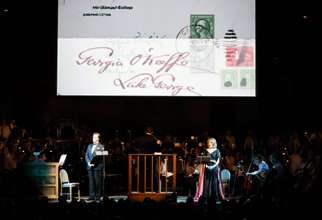|
Back
Yearning, Epic Orchestration with Delicate Touches Lenox
Tanglewood
07/20/2019 -
Edward Elgar: Enigma Variations, Opus 36
Kevin Puts: The Brightness of Light (World Premiere)
Renee Fleming (Georgia O’Keefe), Rod Gilfry (Alfred Stieglitz)
Boston Symphony Orchestra, Andris Nelsons (Conduct)

The Boston Symphony Orchestra under the baton of Andris Nelsons performed The Brightness of Light by Kevin Puts, Pulitzer Prize winner for his opera Silent Night.
The premiere was fortuitously preceded by Edward Elgar’s Enigma Variations. Coming out of the Dark Ages of English classical composition, Elgar revived the country’s reputation by educating himself away from European influence. His wife Alice, who is portrayed in the first of the variations, was his mainstay, always pointing out and encouraging his strengths.
Elgar played many instruments including cello, bass, piano, bassoon and trombone and the violin. He well understood instruments’ special colors and capacities, and composed large orchestration of epic scope as well as exquisite detail.
While Mr. Puts has not yet given us America in all its flawed wonder, in The Brightness of Light he restores the possibilities of the orchestra and more than justifies its sonic possibilities in the current musical scene. While many now argue that listening to music is good for our hearts and our health, first and foremost it has to be good for our ears. Elgar did this in spades over a hundred years ago. Puts also brings us to the center of the musical experience, making us yearn for more.
Yearning may be what both these works are about. The familiar but never familiar enough “Nimrod” variation at the center of the Enigma Variations is so powerful that it survives appropriation by Hans Zimmer for Dunkirk, the film, the 2012 Olympics in London and many funerals, including that of Princess Diana.
Like his predecessor, Puts can delight as he moves us back and forth in scale. Elgar has a dog playing with a stick along the riverside, the laughter of one character in “Ha, ha, has,” and a lovely tribute to a girl he yearned for and could not have. Puts too gives us the delicate play of his characters as they fall in love, in obsession and then separate geographically, even as they remain soul mates.

R. Gilfry, A. Nelsons, R. Fleming (© Hilary Scott)
Rod Gilfry, baritone, and Puts’ collaborator Renee Fleming, appeared together in the premiere of Andre Previn’s Streetcar Named Desire. As Stanley and Blanche, they tortured and disturbed. Undercurrents here also reflect deep, unfufilled feelings. Alfred Stieglitz and Georgia O’Keefe were married for twenty-two years with peaks of passion and support and probing concerns that neither of them could satisfy the other. Often living and working in different parts of America, they corresponded. Puts scoured the correspondence to develop an arc for his orchestral song cycle. He was entranced by the language of the letters of visual artists. O’Keefe wrote that she painted because she could not sing. Fleming now gives her extraordinary melodic lines.
Puts is a gifted composer for the human voice. His operas are rich with melodic line and music which both reflects and drives character. Yet in his operas, words often dominated and left little opportunity for Puts to display his special feeling for orchestration. Becoming his own librettist, we now have an orchestral introduction and two orchestral interludes in which Puts draws as strong a musical portrait of his characters as they do in paint and on film. We are swept into their world, and particularly the world of light which both artists used from original points of view. Puts now gives us light in music.
The photographer and painter meet and are drawn to each other. Their intimacy is portrayed in interwoven melodic lines. As sung by Fleming in her wide range with lush tones, O’Keefe comes to life as a woman obsessed by her art. The vibraphone gives us both a painter’s sense of light, and O’Keefe’s femininity. Video projections remind us both of light and the central erotic vision of O’Keefe. O’Keefe fell in love with New Mexico at the same time Stieglitz took on a new lover in New York. Her pain, drawn by Mr. Puts and sung by Ms. Fleming with great beauty and sadness, is turned into art for which she will forever be remembered.
Rod Gilfry makes a splendid Stieglitz. He is captivated by O’Keefe’s work and then the woman herself. He gives up his marriage and joins O’Keefe, but cannot be faithful. Hurt by her husband’s infidelity, O’Keefe turns to the Southwest, to Abiquiu, New Mexico and Ghost Ranch. There she lived and worked until Stieglitz died and for forty years after his death.
Whether or not Mr. Puts’ work will have the endurance of Elgar, there is no question that he enters the canon of great orchestral songs with this work. Like Elgar, audience and critics alike find him wonderful to listen to as he puts forth a unique voice for our times. The toughest critic of all, George Bernard Shaw, loved Elgar’s music. No doubt he would have appreciated Kevin Puts. The music of both composers makes the argument for an orchestra, that grand beast of so many parts.
Susan Hall
|